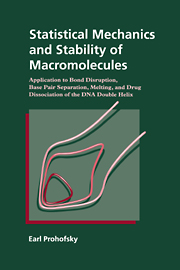 Statistical Mechanics and Stability of Macromolecules
Statistical Mechanics and Stability of Macromolecules Book contents
- Frontmatter
- Contents
- Preface
- 1 Introduction
- 2 Macromolecular stability
- 3 Lattice dynamics
- 4 Effective phonon theory
- 5 Premelting disrupted chemical bonds
- 6 Cooperative melting
- 7 Strained chemical bonds: salt and pressure effects
- 8 Bond disruption and conformation change: B to Z conformation change in DNA
- 9 Hydration effects: structural water
- 10 Helix with daunomycin intercalated: increased helix stability and daunomycin-DNA binding constant
- 11 Nonrepeating DNA
- 12 Cutting and splicing: junctions, inserts, and the replicating fork
- 13 Interaction between a helix and a single attached molecule
- 14 Energy considerations in bond opening
- Appendix 1 Helical lattice dynamics
- Appendix 2 Density matrix and effective phonon theory
- Appendix 3 Green functions
- References
- Index
7 - Strained chemical bonds: salt and pressure effects
Published online by Cambridge University Press: 16 September 2009
- Frontmatter
- Contents
- Preface
- 1 Introduction
- 2 Macromolecular stability
- 3 Lattice dynamics
- 4 Effective phonon theory
- 5 Premelting disrupted chemical bonds
- 6 Cooperative melting
- 7 Strained chemical bonds: salt and pressure effects
- 8 Bond disruption and conformation change: B to Z conformation change in DNA
- 9 Hydration effects: structural water
- 10 Helix with daunomycin intercalated: increased helix stability and daunomycin-DNA binding constant
- 11 Nonrepeating DNA
- 12 Cutting and splicing: junctions, inserts, and the replicating fork
- 13 Interaction between a helix and a single attached molecule
- 14 Energy considerations in bond opening
- Appendix 1 Helical lattice dynamics
- Appendix 2 Density matrix and effective phonon theory
- Appendix 3 Green functions
- References
- Index
Summary
Changes in the ground state problem
As pointed out in Chapter 3, there is a calculational advantage to working in an effective harmonic approximation. All the work discussed so far has used this approximation, i.e. assumed a ground state for each polymer determined from experimental observation. Control variables that could alter that ground state have not been changed, the only control variable allowed to vary is the temperature. Other factors affect DNA melting, such as salt concentration, hydration level, and hydrostatic pressure, and it would be useful to extend the methods developed to study effects of changes in these other control variables. This chapter is about ways to introduce changes in control variables that would normally be thought of as elements affecting the ground state solution. We show that one can selectively put back into the problem particular static or ground state elements, without carrying out a full ground state solution, and determine their effects on the dynamics and melting.
For example, consider increasing the hydrostatic pressure on a system containing double helices. The atoms would be pushed closer together, altering the interatom distances in the ground state. Another example would be changes in salt concentration in the environment of the helix. Altering salt concentration changes the shielding of the Coulomb interaction between the highly charged phosphate groups, which would alter the static equilibrium positions in the helix.
- Type
- Chapter
- Information
- Statistical Mechanics and Stability of MacromoleculesApplication to Bond Disruption, Base Pair Separation, Melting, and Drug Dissociation of the DNA Double Helix, pp. 103 - 116Publisher: Cambridge University PressPrint publication year: 1995


